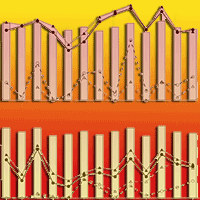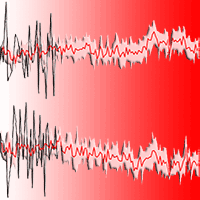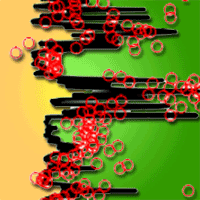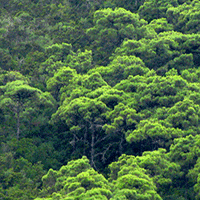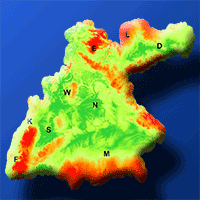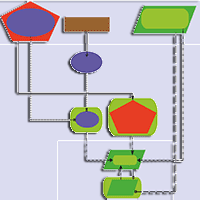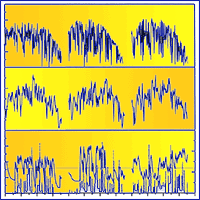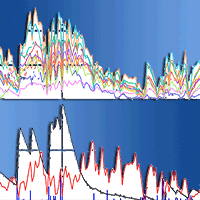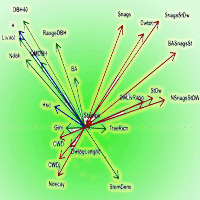Two drought stress indices were applied to managed as well as old-growth beech forests and gaps for the 2001 to 2013 period to aid in the development of an efficient tool for field water supply diagnosis. The relative extractable soil water (REW), which was calculated from the soil water content in the root zone, and the transpiration index (TI), calculated as the ratio between the actual and potential transpiration were used. Both indices were calculated on a daily basis using the water balance model BROOK90, which was fitted and tested using measured data on throughfall and soil water content. A sensitivity analysis apportioned to the input parameters of the drought stress indices was conducted to assess uncertainty. Both drought stress indices showed the greatest drought stress in the years 2009, 2003 and 2011, as also indicated by the Standardized Precipitation Evapotranspiration Index (SPEI) at the nearest meteorological station. However, drought stress intensity and duration differed between the indices and study sites. Greater water supply stress was shown in the forests than the gaps. Furthermore, the agreement among the indices was smaller for gaps compared with forests, which implies that careful index selection is needed when comparing water supply stresses in different stages of forest stand development. Due to the low amount of input data required and the parameters that can be measured with relative ease in the field, REW might be an efficient tool for field water supply diagnosis when analyzing the drought stresses of similar forest types and at unique stages of development. REW satisfactorily indicated drought stress in forests but to a lesser extent in gaps. TI demonstrated more consistent differences in drought stress between forests and gaps and therefore proved to be the appropriate index for a detailed analysis of drought stress variation between different stages of forest stand development. However, due to a greater number of required input data and more demanding parameters, TI appears to be a more complex tool than REW for field water supply diagnosis in forests.
Keywords
, , , , , , ,
Citation
Vilhar U (2016). Comparison of drought stress indices in beech forests: a modelling study. iForest 9: 635-642. - doi: 10.3832/ifor1630-008
Academic Editor
Tamir Klein
Paper history
Received: Mar 03, 2015
Accepted: Dec 12, 2015
First online: May 06, 2016
Publication Date: Aug 09, 2016
Publication Time: 4.87 months
© SISEF - The Italian Society of Silviculture and Forest Ecology 2016
Open Access
This article is distributed under the terms of the Creative Commons Attribution-Non Commercial 4.0 International (https://creativecommons.org/licenses/by-nc/4.0/), which permits unrestricted use, distribution, and reproduction in any medium, provided you give appropriate credit to the original author(s) and the source, provide a link to the Creative Commons license, and indicate if changes were made.

Breakdown by View Type
(Waiting for server response...)
Article Usage
Total Article Views: 51338
(from publication date up to now)
Breakdown by View Type
HTML Page Views: 42033
Abstract Page Views: 3375
PDF Downloads: 4375
Citation/Reference Downloads: 49
XML Downloads: 1506
Web Metrics
Days since publication: 3524
Overall contacts: 51338
Avg. contacts per week: 101.98
Article Citations
Article citations are based on data periodically collected from the Clarivate Web of Science web site
(last update: Mar 2025)
Total number of cites (since 2016): 19
Average cites per year: 1.90
Publication Metrics
by Dimensions ©
Articles citing this article
List of the papers citing this article based on CrossRef Cited-by.
(1)
Allen RG, Pereira LS, Raes D, Smith M (1998)Crop evapotranspiration. Guidelines for computing crop water requirements. FAO irrigation and drainage paper no. 65, FAO, Rome, Italy, pp. 300.
Online |
Gscholar
(2)
Anderegg LDL, Anderegg WRL, Abatzoglou J, Hausladen AM, Berry JA (2013a)Drought characteristics role in widespread aspen forest mortality across Colorado, USA. Global Change Biology 19: 1526-1537.
CrossRef |
Gscholar
(3)
Anderegg LDL, Anderegg WRL, Berry JA (2013b)Not all droughts are created equal: translating meteorological drought into woody plant mortality. Tree Physiology 33: 701-712.
CrossRef |
Gscholar
(4)
Bergès L, Balandier P (2010)Revisiting the use of soil water budget assessment to predict site productivity of sessile oak (
Quercus petraea Liebl.) in the perspective of climate change. European Journal of Forest Research 129: 199-208.
CrossRef |
Gscholar
(5)
Bertini G, Amoriello T, Fabbio G, Piovosi M (2011)Forest growth and climate change: evidences from the ICP-Forests intensive monitoring in Italy. iForest 4: 262-267.
CrossRef |
Gscholar
(6)
Bréda N, Huc R, Dreyer E, Granier A (2006)Temperate forest trees and stands under severe drought: a review of ecophysiological responses, adaptation processes and long-term consequences. Annals of Forest Science 63: 625-644.
CrossRef |
Gscholar
(7)
Briceno-Elizondo E, Garcia-Gonzalo J, Peltola H, Matala J, Kellomaki S (2006)Sensitivity of growth of Scots pine, Norway spruce and silver birch to climate change and forest management in boreal conditions. Forest Ecology and Management 232: 152-167.
CrossRef |
Gscholar
(8)
Cermák J, Kucera J, Nadezhdina N (2004)Sap flow measurements with some thermodynamic methods, flow integration within trees and scaling up from sample trees to entire forest stands. Trees 18 (5): 529-546.
CrossRef |
Gscholar
(9)
Cermák J, Matyssek R, Kucera J (1993)Rapid response of large, drought-stressed beech trees to irrigation. Tree Physiology 12: 281-290.
CrossRef |
Gscholar
(10)
Cermák J, Ulehla J, Kučera J, Penka M (1982)Sap flow rate and transpiration dynamics in the full-grown oak (
Quercus robur L.) in floodplain forest exposed to seasonal floods as related to potential evapotranspiration and tree dimensions. Biologia Plantarum (Praha) 24: 446-460.
CrossRef |
Gscholar
(11)
Cienciala E, Eckersten H, Lindroth A, Hällgren J-E (1994)Simulated and measured water uptake by
Picea abies under non-limiting soil water conditions. Agricultural and Forest Meteorology 71: 147-164.
CrossRef |
Gscholar
(12)
Cognard-Plancq A-L, Marc V, Didon-Lescot J-F, Norman M (2001)The role of forest cover on streamflow down sub-Mediterranean mountain watersheds: a modelling approach. Journal of Hydrology 254: 229-243.
CrossRef |
Gscholar
(13)
Dalsgaard L (2007)Above and belowground gaps-the effects of small canopy opening on throughfall, soil moisture and tree transpiration in Suserup Skov, Denmark. Ecological Bulletins 52: 81-102.
Gscholar
(14)
Dirksen C (1999)Soil physics measurements. Catena Verl., Reiskirchen, Germany, pp. 154.
Online |
Gscholar
(15)
Dogan S, Berktay A, Singh VP (2012)Comparison of multi-monthly rainfall-based drought severity indices, with application to semi-arid Konya closed basin, Turkey. Journal of Hydrology 470- 471: 255-268.
CrossRef |
Gscholar
(16)
Dyer JM (2009)Assessing topographic patterns in moisture use and stress using a water balance approach. Landscape Ecology 24: 391-403.
CrossRef |
Gscholar
(17)
Federer CA (1995)BROOK90 manual: a simulation model for evaporation, soil water and streamflow, version 3.1. USDA Forest Service, Durham, NH, USA, pp. 40.
Gscholar
(18)
Federer CA (2002)BROOK90: a simulation model for evaporation, soil water, and streamflow. Version 4.4g. Computer freeware, C. Anthony Federer, Falmouth ME 04105, USA.
Online |
Gscholar
(19)
Federer CA, Vorosmarthy C, Fekete B (2003)Sensitivity of annual evaporation to soil and root properties in two models of contrasting complexity. Journal of Hydrometeorology 4: 1276-1290.
CrossRef |
Gscholar
(20)
Ferlan M, Simončič P (2012)Robust and cost-effective system for measuring and logging of data on soil water content and soil temperature profile. Agricultural Sciences 3: 865-870.
CrossRef |
Gscholar
(21)
Granier A, Biron P, Lemoine D (2000)Water balance, transpiration and canopy conductance in two beech stands. Agricultural and Forest Meteorology 100: 291-308.
CrossRef |
Gscholar
(22)
Granier A, Breda N, Biron P, Villette S (1999)A lumped water balance model to evaluate duration and intensity of drought constraints in forest stands. Ecological Modelling 116: 269-283.
CrossRef |
Gscholar
(23)
Granier A, Loustau D (1994)Measuring and modelling the transpiration of a maritime pine canopy from sap-flow data. Agricultural and Forest Meteorology 71: 61-81.
CrossRef |
Gscholar
(24)
Granier A, Reichstein M, Breda N, Janssens IA, Falge E, Ciais P, Gruenwald T, Aubineth M, Berbigier P, Bernhofer C, Buchmann N, Facini O, Grassi G, Heinesch B, Ilvesniemi H, Keronen P, Knohl A, Koestner B, Lagergren F, Lindroth A, Longdoz B, Loustau D, Mateus J, Montagnani L, Nys C, Moors E, Papale D, Peiffer M, Pilegaard K, Pita G, Pumpanen J, Rambal S, Rebmann C, Rodrigues A, Seufert G, Tenhunen J, Vesala T, Wang Q (2007)Evidence for soil water control on carbon and water dynamics in European forests during the extremely dry year: 2003. Agricultural and Forest Meteorology 143: 123-145.
CrossRef |
Gscholar
(25)
Graphpad (2014)GraphPad Prism. Software MacKiev, La Jolla, CA, USA.
Online |
Gscholar
(26)
Gray A, Spies T (1996)Gap size, within-gap position and canopy structure effects on conifer seedling establishment. Journal of Ecology 84: 635-645.
CrossRef |
Gscholar
(27)
Gray A, Spies T, Easter M (2002)Microclimatic and soil moisture responses to gap formation in coastal Douglas-fir forests. Canadian Journal of Forest Research 32: 332-343.
CrossRef |
Gscholar
(28)
Hammel K, Kennel M (2001)Charakterisierung und Analyse der Wasserverfuegbarkeit und des Wasserhaushalts von Waldstandorten in Bayern mit dem Simulationsmodell BROOK90 [Characterization and analysis of water availability and the water balance of forest sites in Bavaria with the simulation model BROOK90]. Forstliche Forschungsberichte München 185: 135. [in German]
Gscholar
(29)
Kolström M, Lindner M, Vilén T, Maroschek M, Seidl R, Lexer MJ, Netherer S, Kremer A, Delzon S, Barbati A, Marchetti M, Corona P (2011)Reviewing the science and implementation of climate change adaptation measures in European forestry. Forests 4: 961-982.
CrossRef |
Gscholar
(30)
Kutnar L, Kobler A (2011)Prediction of forest vegetation shift due to different climate-change scenarios in Slovenia. Sumarski list 135: 113-126.
Gscholar
(31)
Lagergren F, Lindroth A (2002)Transpiration response to soil moisture in pine and spruce trees in Sweden. Agricultural and Forest Meteorology 112: 67-85.
CrossRef |
Gscholar
(32)
Lebourgeois F, Gomez N, Pinto P, Mérian P (2013)Mixed stands reduce
Abies alba tree-ring sensitivity to summer drought in the Vosges mountains, western Europe. Forest Ecology and Management 303: 61-71.
CrossRef |
Gscholar
(33)
Madsen P, Hahn K (2008)Natural regeneration in a beech-dominated forest managed by close-to-nature principles - a gap cutting based experiment. Canadian Journal of Forest Research 38: 1716-1729.
CrossRef |
Gscholar
(34)
Matejka F, Srelcová K, Hurtalová T, Gomoryová E (2007)Modelling transpiration and soil water potential in a spruce primeval forest during dry period. In: Proceedings of the International Scientific Conference on “Bioclimatology and natural hazards”. Polana nad Detvou (Slovakia) 17-20 Sep 2007. Ceská bioklimatologická společnost, Praha, Czech Republic, pp. 1-7.
Gscholar
(35)
Michelot A, Bréda N, Damesin C, Dufrêne E (2012)Differing growth responses to climatic variations and soil water deficits of
Fagus sylvatica, Quercus petraea and
Pinus sylvestris in a temperate forest. Forest Ecology and Management 265: 161-171.
CrossRef |
Gscholar
(36)
Mishra AK, Singh VP (2010)A review of drought concepts. Journal of Hydrology 391: 202-216.
CrossRef |
Gscholar
(37)
Nikolova PS, Raspe S, Andersen CP, Mainiero R, Blaschke H, Matyssek R, Häberle K-H (2009)Effects of the extreme drought in 2003 on soil respiration in a mixed forest. European Journal of Forest Research 128: 87-98.
CrossRef |
Gscholar
(38)
Palahi M, Mavsar R, Gracia C, Birot Y (2008)Mediterranean forests under focus. International Forestry Review 10: 676-688.
CrossRef |
Gscholar
(39)
Piedallu C, Gégout J-C, Perez V, Lebourgeois F (2013)Soil water balance performs better than climatic water variables in tree species distribution modelling. Global Ecology and Biogeography 22: 470-482.
CrossRef |
Gscholar
(40)
Puncer I (1980)Dinarski jelovo-bukovi gozdovi na Kočevskem [Dinaric silver fir - beech forests in Kočevje region]. Razprave 22: 161. [in Czech]
Gscholar
(41)
Ritter E (2004)The effect of gap formation on soil temperature, soil water, and processes in the nitrogen cycle in temperate beech forests of different management intensities. PhD Thesis, The Royal Veterinary and Agricultural Univerity, Copenhagen, Denmark, pp. 232.
Gscholar
(42)
Ritter E, Vesterdal L (2006)Gap formation in Danish beech (
Fagus sylvatica) forests of low management intensity: soil moisture and nitrate in soil solution. European Journal of Forest Research 125: 139-150.
CrossRef |
Gscholar
(43)
Schwärzel K, Feger K-H, Häntzschel J, Menzer A, Spank U, Clausnitzer F, Köstner B, Bernhofer C (2009a)A novel approach in model-based mapping of soil water conditions at forest sites. Forest Ecology and Management 258: 2163-2174.
CrossRef |
Gscholar
(44)
Schwärzel K, Menzer A, Clausnitzer F, Spank U, Haentzschel J, Gruenwald T, Koestner B, Bernhofer C, Feger K-H (2009b)Soil water content measurements deliver reliable estimates of water fluxes: A comparative study in a beech and a spruce stand in the Tharandt forest (Saxony, Germany). Agricultural and Forest Meteorology 149: 1994-2006.
CrossRef |
Gscholar
(45)
Shuttleworth WJ, Wallace JS (1985)Evaporation from sparse crops - an energy combination theory. Quarterly Journal of the Royal Meteorological Society 111 (469): 839-855.
CrossRef |
Gscholar
(46)
Sohn JA, Gebhardt T, Ammer C, Bauhus J, Häberle K-H, Matyssek R, Grams TEE (2013)Mitigation of drought by thinning: Short-term and long-term effects on growth and physiological performance of Norway spruce (
Picea abies). Forest Ecology and Management 308: 188-197.
CrossRef |
Gscholar
(47)
Stojanović DB, Kržič A, Matović B, Orlović S, Duputie A, Djurdjević V, Galić Z, Stojnić S (2013)Prediction of the European beech (
Fagus sylvatica L.) xeric limit using a regional climate model: an example from southeast Europe. Agricultural and Forest Meteorology 176: 94-103.
CrossRef |
Gscholar
(48)
Tegel W, Seim A, Hakelberg D, Hoffmann S, Panev M, Westphal T, Büntgen U (2014)A recent growth increase of European beech (
Fagus sylvatica L.) at its Mediterranean distribution limit contradicts drought stress. European Journal of Forest Research 133: 61-71.
CrossRef |
Gscholar
(49)
Thompson SA (1999)Hydrology for water management. Balkema, Rotterdam, The Netherlands, pp. 476.
Online |
Gscholar
(50)
Urbančič M, Simončič P, Cater M (2005)Impacts of gaps on humus forms in dinaric silver fir-beech (
Omphalodo-Fagetum) and soil solution quality. Mitteilungen Österreichiches Bodenkdunde Geselschaft 72: 179-187.
Gscholar
(51)
Vicente-Serrano SM, Beguería S, López-Moreno JI (2010)A multi-scalar drought index sensitive to global warming: the standardized precipitation evapotranspiration index-SPEI. Journal of Climate 23: 1696-1718.
CrossRef |
Gscholar
(52)
Vilhar U, Nadezhdina N, Cermak J, Gasparek J, Urbančič M, Simončič P (2006a)Meritve in modeliranje transpiracije podsajene bukve v smrekovem sestoju na Pohorju [Measuring and modeling of the transpiration of underplanted beech in spruce stand on Pohorje]. In: “Splošne ekološke in gozdnogojitvene osnove za podsadnjo bukve (
Fagus sylvatica L.) v antropogenih smrekovih sestojih” (Simončič P, Cater M eds). Silva Slovenica,Gozdarski Inštitut Slovenije, Ljubljana, vol. 129, pp. 86-103. [in Slovenian]
Gscholar
(53)
Vilhar U, Roenbergar D, Simončič P, Diaci J (2015)Variation in irradiance, soil features and regeneration patterns in experimental forest canopy gaps. Annals of Forest Science 72: 253-266.
CrossRef |
Gscholar
(54)
Vilhar U, Simončič P (2012)Water status and drought stress after gap formation in managed and semi-natural silver fir-beech forests. European Journal of Forest Research 131: 1381-1397.
CrossRef |
Gscholar
(55)
Vilhar U, Simončič P, Kajfe-Bogataj L, Katzensteiner K, Diaci J (2006b)Mikroklimatske razmere v vrzelih in sestojih dinarskega jelovo-bukovega gozda [Microclimate conditions in gaps and mature stands of Dinaric silver fir-beech forests]. Zbornik gozdarstva in lesarstva 81: 21-36. [in Slovenian]
Gscholar
(56)
Vilhar U, Starr M, Urbančič M, Smolej I, Simončič P (2005)Gap evapotranspiration and drainage fluxes in a managed and a virgin dinaric silver fir-beech forest in Slovenia: a modelling study. European Journal of Forest Research 124: 165-175.
CrossRef |
Gscholar
(57)
Wellpott A, Imbery F, Schindler D, Mayer H (2005)Simulation of drought for a Scots pine forest (
Pinus sylvestris L.) in the southern upper Rhine plain. Meteorologische Zeitschrift 14: 143-150.
CrossRef |
Gscholar
(58)
Zahner R (1967)Refinement in empirical functions for realistic soil-moisture regimes under forest cover. Forest Hydrology. In: Proceedings of the “National Science Foundation Advanced Science Seminar”. Pergamon Press, Oxford, Pennsylvania State University, PA, USA, pp. 261-273.
Gscholar
(59)
Zhou J, Zhang Z, Sun G, Fang X, Zha T, Mcnulty S, Chen J, Jin Y, Noormets A (2013)Response of ecosystem carbon fluxes to drought events in a poplar plantation in Northern China. Forest Ecology and Management 300: 33-42.
CrossRef |
Gscholar
(60)
Zierl B (2001)A water balance model to simulate drought in forested ecosystems and its applications to the entire forested area in Switzerland. Journal of Hydrology 242: 115-136.
CrossRef |
Gscholar
(61)
Zierl B (2004)A simulation study to analyse the relations between crown condition and drought in Switzerland. Forest Ecology and Management 188: 25-38.
CrossRef |
Gscholar
(62)
Zirlewagen D, Von Wilpert K (2001)Modeling water and ion fluxes in a highly structured, mixed-species stand. Forest Ecology and Management 143: 27-37.
CrossRef |
Gscholar
